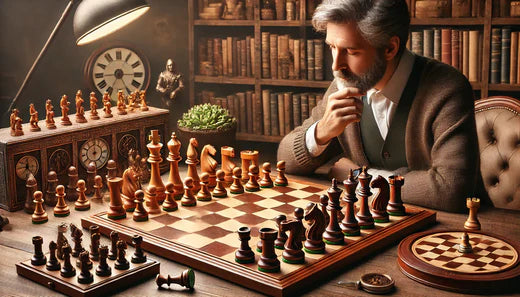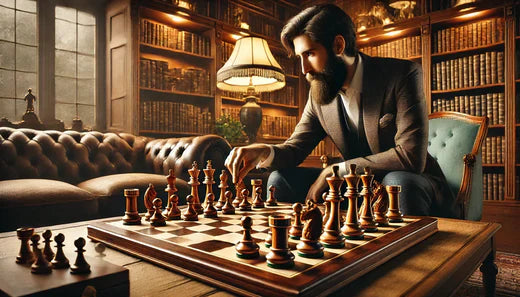The Art and Craft of Manufacturing Chess Products
Chess, a game of strategy and intellect, has long been associated with sophistication and tradition. But beyond the gameplay lies the intricate and labour-intensive process of creating chess sets, boards, and boxes. At The English Chess Company, each product is a testament to craftsmanship, dedication, and an unwavering commitment to quality. This article delves into the processes behind manufacturing our chess products and invites you to appreciate the artistry and effort that go into bringing them to retail-worthy standards.
1. The Journey of Chess Piece Crafting
1.1 Selection of Materials
The creation of high-quality chess pieces begins with the careful selection of materials. The most commonly used woods include:
- Boxwood: Ideal for light-coloured pieces due to its smooth texture and durability.
- Ebony and Rosewood: Favoured for dark pieces, offering a rich, luxurious finish.
1.2 Precision Turning and Carving
-
Lathe Turning:
- Skilled artisans use lathes to shape the basic forms of each piece. This process requires precision to ensure uniformity across all pawns, rooks, and knights.
-
Hand-Carving:
- Knights are meticulously hand-carved to achieve intricate details, such as their manes and facial expressions.
- Each piece is individually crafted to maintain uniqueness while adhering to Staunton design standards.
1.3 Sanding and Polishing
The raw pieces undergo multiple rounds of sanding to achieve a smooth surface. This is followed by polishing using:
- Natural waxes for a matte finish.
- Lacquers for a high-gloss sheen.
1.4 Weighting and Felting
-
Weighting:
- Metal inserts are added to the base of each piece to ensure stability and a satisfying heft.
-
Felting:
- Soft felt is applied to the bottom of the pieces to protect the chessboard from scratches.
2. The Intricacies of Chess Board Manufacturing
2.1 Material Choices
Chess boards are crafted from premium woods such as:
- Walnut and Maple: Popular for their contrasting tones and durability.
- Mahogany: Chosen for its deep, rich colour.
- Anegre: A fine-grained wood used in luxury boards.
2.2 Veneer Inlaying
The process of creating a chessboard involves precise veneer inlaying:
-
Cutting:
- Veneers are cut into squares, ensuring perfect dimensions.
-
Arranging:
- Dark and light squares are alternately arranged to form the iconic 8x8 grid.
-
Adhering:
- The squares are adhered to a baseboard, often made of engineered wood for stability.
2.3 Edge Banding
The edges of the board are finished with strips of wood, known as edge banding, to enhance durability and aesthetics.
2.4 Sanding and Finishing
After assembly, the board is sanded to a smooth finish and treated with protective coatings:
- Matte Finish: For a classic, understated look.
- Gloss Finish: For a striking, polished appearance.
3. Crafting Chess Boxes: Protecting Your Pieces
3.1 Designing for Functionality
Chess boxes are designed to:
- Protect chess pieces from dust and damage.
- Provide an organised storage solution.
3.2 Material Selection
Premium woods such as mahogany and walnut are commonly used. For budget-friendly options, engineered wood with veneer is employed.
3.3 Construction Process
-
Cutting and Shaping:
- Panels are cut and shaped to precise dimensions.
-
Assembly:
- Panels are joined using high-strength adhesives and screws.
-
Internal Lining:
- Velvet or felt linings are added to cushion the pieces.
-
Finishing Touches:
- Hinges, locks, and other hardware are carefully installed.
4. Quality Control and Retail Preparation
4.1 Rigorous Quality Checks
Before any product reaches our customers, it undergoes extensive quality control:
- Dimensional Accuracy: Ensuring pieces and boards meet size specifications.
- Aesthetic Inspection: Checking for smooth finishes and consistent colouring.
- Durability Testing: Verifying the robustness of boards, pieces, and boxes.
4.2 Packaging for Retail
Each product is carefully packaged to ensure it arrives in pristine condition:
- Chess pieces are individually wrapped.
- Boards are cushioned with foam inserts.
- Boxes are secured with protective padding.
5. Why Our Chess Products Stand Out
5.1 Commitment to Craftsmanship
Every product reflects our dedication to traditional craftsmanship and modern techniques. From hand-carved knights to precision inlaid boards, quality is our hallmark.
5.2 Sustainability Efforts
We source our materials ethically, prioritising sustainability:
- Use of FSC-certified woods.
- Minimising waste through efficient manufacturing processes.
5.3 Supporting Local Artisans
Our products are crafted by skilled artisans, many of whom have honed their skills over generations. By purchasing from us, you support:
- The preservation of traditional crafts.
- Fair wages and ethical labour practices.
6. Bringing Tradition to Modern Retail
6.1 Balancing Tradition and Innovation
While we honour traditional techniques, we also embrace modern innovations:
- Computer-aided design (CAD) for precise templates.
- Advanced machinery for efficiency without compromising quality.
6.2 Customer-Centric Approach
We prioritise our customers by:
- Offering customisation options.
- Providing detailed product information and care guides.
7. The Value of Craftsmanship
The journey of crafting chess products is one of dedication, artistry, and precision. At The English Chess Company, we take immense pride in offering products that embody these qualities. By choosing our chess sets, boards, and boxes, you’re not just purchasing a game—you’re investing in a piece of art, a testament to tradition, and a commitment to quality.
Explore our collection and witness the craftsmanship for yourself at The English Chess Company.



